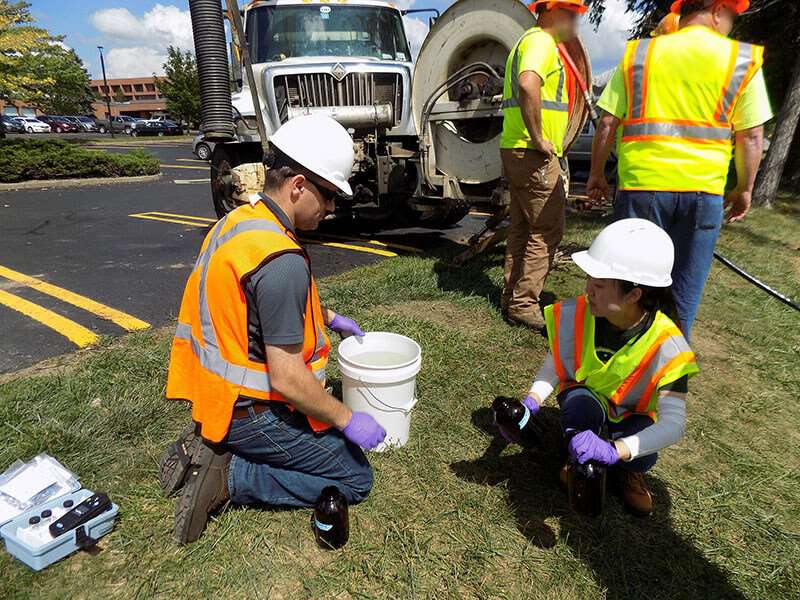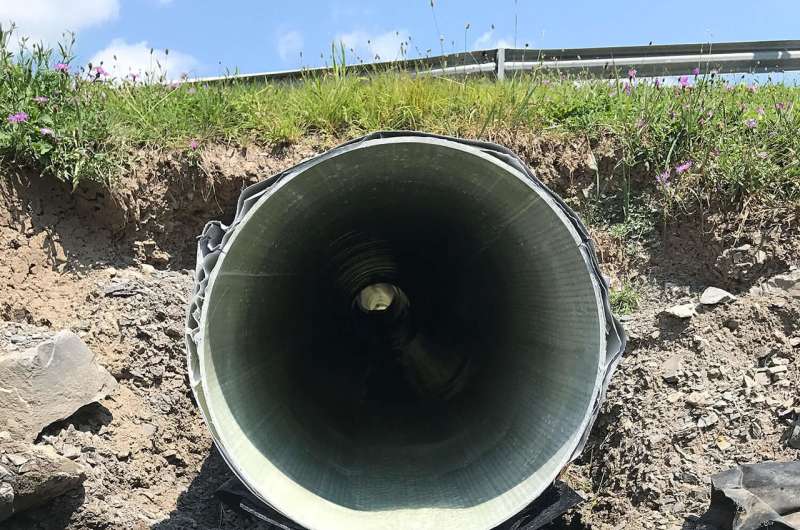Review of common construction practice finds environmental contamination, need for improved oversight and monitoring

An in-depth review of environmental protections for a common storm water culvert repair practice—cured-in-place pipe repair, or CIPP—has revealed differing installation practices across states, water contamination incidents in 10 states and Canada, and lack of safety data for existing installation practices.
Funded by six states, Purdue University researchers examined past water contamination incidents, environmental studies, industry practices and construction specifications from 32 states.
Creek, river, pond, and sometimes drinking water contamination incidents were found in 10 states: Alabama, California, Colorado, Connecticut, Florida, Georgia, Minnesota, Oregon, Vermont and Washington.
Of the 32 states that responded to the researchers' request for information, only four states required water testing after the construction procedure, and the test methods used were often not the same. Nine states had no formal requirements to oversee or monitor the procedure's environmental impacts.
Andrew Whelton, associate professor of civil engineering and environmental and ecological engineering, says many states and municipalities are beginning to re-examine how CIPP is used and lessen the potential harm to nearby water and air.
"State transportation agencies want to repair their infrastructure without having to worry about fish kills, drinking water contamination, or chemical incident cleanup," he says. "There have been some significant incidents."
Storm water culverts allow water to flow under roadways. When culverts fail, roadways can collapse and flood, thereby, jeopardizing public safety.
A popular method of repairing culverts, CIPP utilizes resin-impregnated fabric that is hardened inside a damaged pipe using pressurized steam, hot water, or UV light, creating a new plastic pipe inside the old, damaged pipe.
The process, if not well controlled, can release a worrisome mix of hazardous chemicals into the air and water, although what exactly is discharged, and how that varies site to site, is just beginning to be understood.
"In 2014, waste produced at an Alabama culvert repair site was found to be acutely contaminated and dissolved a freshwater organism," Whelton says. "While the technology has been around for 30 years, there are very few laboratory and field studies on possible environmental effects."
Previous research found that the chemical plume created during the steam-based CIPP installation process released chemical vapors, not just steam. It also contained known air pollutants, suspected endocrine-disrupting chemicals, and known and suspected carcinogens. The California Department of Public Health issued a statewide notice about potential hazards after its own investigation and the prior study.
As part of the review, graduate student Kyungyeon Ra stated that at one Colorado site, "People reported an odor in their drinking water."
Upon investigation, the community discovered high styrene levels in their drinking water, which were traced back to an upstream storm water culvert repair gone wrong, she said.
"We are continuing to investigate whether the 13 water contamination incidents we found are outliers or are typical of CIPP installations," she says, though, water contamination was reported for all of the field studies reviewed.
As part of her research, Kyungyeon found that although styrene—suspected to be a carcinogen—was the chemical most often reported in the 13 incidents studied, acetone, benzene, trimethylbenzenes, among others, were also sometimes found.
Chad Jafvert, a professor of civil engineering and environmental and ecological engineering, says the purpose of the research is to better understand CIPP risks and incident causes.

"This research is being performed to identify any environmental exposures from CIPP and find ways to improve the practice to make this technology safer for the environment and for people," Jafvert said.
John Howarter, assistant professor of civil engineering and environmental and ecological engineering, echoed the need for more data and open communication regarding the risks of infrastructure repair. "This report summarized data from many independent state agencies; being able to see the big picture will help reduce incident risks," he said.
Based on the research team's findings, they recommend that those who perform, oversee, and monitor CIPP repairs enact several precautions until more research is conducted. Recommendations include:
- Contractors should use impermeable plastic sheets immediately upstream and downstream of the pipe to prevent materials from entering the environment.
- Water flow should be diverted from the pipe until a complete resin cure has been established. This can vary depending on the material used, as well as the thickness of the material, the curing method, the condition of the pipe, and the ambient temperature.
- The new CIPP should be rinsed with water and the waste collected.
- Nearby waters should be tested before and after the repair for a variety of chemicals, not just styrene.
The research was funded by six state transportation agencies under the Transportation Pooled Fund Program.
The study follows prior work by several transportation agencies and Purdue University researchers to better understand how to limit chemical emissions and environmental impacts.
"Health officials and worker safety professionals will also benefit from this study. Similar construction practices and materials are used for sanitary sewer CIPP installations," Whelton said.
More information: Matthew L. Tabor et al. Stormwater Chemical Contamination Caused by Cured-in-Place Pipe (CIPP) Infrastructure Rehabilitation Activities, Environmental Science & Technology (2014). DOI: 10.1021/es5018637
Kyungyeon Ra et al. Critical Review: Surface Water and Stormwater Quality Impacts of Cured-In-Place Pipe Repairs, Journal - American Water Works Association (2018). DOI: 10.1002/awwa.1042
Journal information: Environmental Science & Technology , Journal - American Water Works Association
Provided by Purdue University



















